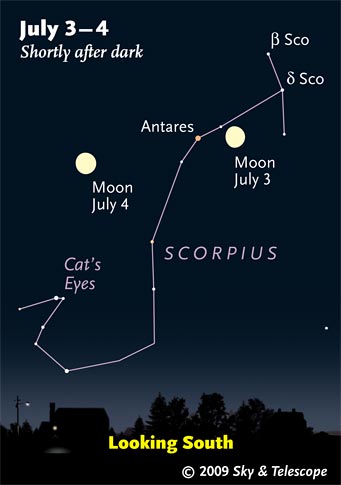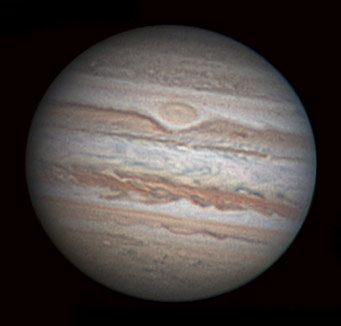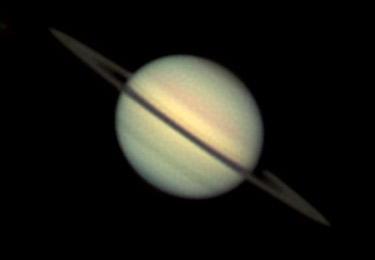Some daily events in the changing sky for July 3 – 11.

The Moon crosses Scorpius as the holiday weekend begins.
Sky & Telescope diagram
Antares glitters just a few degrees left of the waxing gibbous Moon as seen from North America this evening, as shown at right. Seen from Hawaii, the Moon occults (covers) Antares around midnight (details).
Saturday, July 4
Sunday, July 5
Monday, July 6
Tuesday, July 7
Wednesday, July 8
Thursday, July 9
Friday, July 10
Saturday, July 11
Want to become a better amateur astronomer? Learn your way around the constellations. They're the key to locating everything fainter and deeper to hunt with binoculars or a telescope. For an easy-to-use constellation guide covering the whole evening sky, use the big monthly map in each issue of Sky & Telescope, the essential magazine of astronomy. Or download our free Getting Started in Astronomy booklet (which only has bimonthly maps).
Sky Atlas 2000.0 (the color Deluxe Edition is shown here) plots 81,312 stars to magnitude 8.5. That includes most of the stars that you can see in a good finderscope, and typically one or two stars that will fall within a 50× telescope's field of view wherever you point. About 2,700 deep-sky objects to hunt are plotted among the stars.
Alan MacRobert
Once you get a telescope, to put it to good use you'll need a detailed, large-scale sky atlas (set of charts; the standards are Sky Atlas 2000.0 or the smaller Pocket Sky Atlas) and good deep-sky guidebooks (such as Sky Atlas 2000.0 Companion by Strong and Sinnott, the more detailed and descriptive Night Sky Observer's Guide by Kepple and Sanner, or the classic Burnham's Celestial Handbook). Read how to use them effectively.
Can a computerized telescope take their place? I don't think so — not for beginners, anyway, and especially not on mounts that are less than top-quality mechanically. As Terence Dickinson and Alan Dyer say in their Backyard Astronomer's Guide, "A full appreciation of the universe cannot come without developing the skills to find things in the sky and understanding how the sky works. This knowledge comes only by spending time under the stars with star maps in hand and a curious mind." Without these, "the sky never becomes a friendly place."
More beginners' tips: "How to Start Right in Astronomy".
This Week's Planet Roundup

Jupiter's Great Red Spot (rather pale this year) was crossing the planet's central meridian when Fabio Carvalho of Sao Carlos, Brazil, took this image on July 2nd. Also note the sharply defined Red Spot Hollow, and the very active, turbulent North Equatorial Belt. South is up. The central meridian longitude at the time of the image was 136° (System II). Carvalho used a 10-inch f/6 Newtonian reflector and a SkyNyx 2-OM camera.
For all of the Red Spot's central-meridian crossing times, good worldwide, use our Red Spot calculator or print out our list for 2009.
Mercury is hidden in the glow of dawn.
Venus and Mars (magnitudes –4.2 and +1.1, respectively) are due east during dawn. Venus is a dazzler; Mars, to Venus's upper right, is 130 times fainter. They're moving farther apart, from 5° to 7½° separation this week. Look below Venus for twinkly Aldebaran, similar to Mars in brightness.
Four reasons combine to create their great brightness disparity. Mars is farther from the Sun so it's illuminated less brightly than Venus; Mars is a smaller planet; its surface is darker and less reflective than Venus's white clouds; and Mars is currently farther from Earth.
Jupiter (magnitude –2.7, in Capricornus) rises around 10 or 11 p.m. daylight saving time and shines brightly in the south at dawn. The sharpest telescopic glimpses may come during morning twilight, when the atmospheric seeing sometimes turns very steady.

On June 16th Saturn's rings were still tipped 3.7° to our line of sight, but they were tipped a mere 0.8° to the incoming sunlight. All year the rings' tilt to the Sun has been steadily decreasing, and accordingly, the rings have been getting darker and darker. Keep watch! Saturn is becoming harder to observe as it moves lower in the west each evening.
S&T's Sean Walker took this stacked-video image using a 14-inch Schmidt-Cassegrain scope at f/22, a DMK21AU04.AS camera, and Custom Scientific RGB filters.
S&T: Sean Walker
Saturn (magnitude +1.0, in Leo) glows in the west at dusk and sinks lower as evening advances. Look early! In a telescope Saturn's rings are narrowing, appearing only 3° from edge on. And see how they've dimmed. The caption at right tells why.
Uranus (magnitude 5.8, in Pisces), is high in the southeast before dawn.
Neptune (magnitude 7.9, in Capricornus) remains only 0.6° from Jupiter, but it's 17,000 times fainter. See our finder charts for Uranus and Neptune.
Pluto (14th magnitude, in northwestern Sagittarius) is at its highest in the south before midnight. See the finder chart in the June Sky & Telescope, page 53.
All descriptions that relate to your horizon or zenith — including the words up, down, right, and left — are written for the world's mid-northern latitudes. Descriptions that also depend on longitude (mainly Moon positions) are for North America. Eastern Daylight Time (EDT) equals Universal Time (also known as UT, UTC, or GMT) minus 4 hours.
"Science is built up of facts, as a house is with stones. But a collection of facts is no more a science than a heap of stones is a house."
— Henri Poincaré (1854–1912)
To be sure to get the current Sky at a Glance, bookmark this URL:
http://SkyandTelescope.com/observing/ataglance?1=1
If pictures fail to load, refresh the page. If they still fail to load, change the 1 at the end of the URL to any other character and try again.
 0
0
Comments
You must be logged in to post a comment.